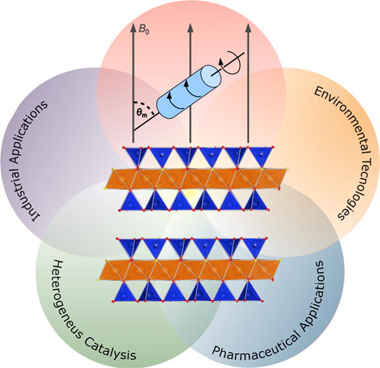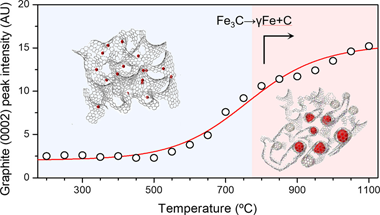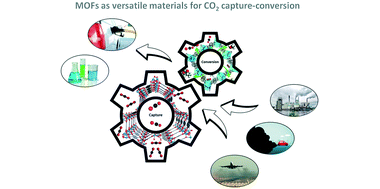Scientific Papers in SCI
2021
2021
Materiales de Diseño para la Energía y Medioambiente
Swelling layered minerals applications: A solid state NMR overview
Pavon, E; Alba, MDProgress in Nuclear Magnetic Resonance Spectroscopy, 124 (2021) 99-128
Show abstract ▽

Swelling layered clay minerals form an important sub-group of the phyllosilicate family. They are characterized by their ability to expand or contract in the presence or absence of water. This property makes them useful for a variety of applications, ranging from environmental technologies to heteroge-neous catalysis, and including pharmaceutical and industrial applications. Solid State Nuclear Magnetic Resonance (SS-NMR) has been extensively applied in the characterization of these materials, providing useful information on their dynamics and structure that is inaccessible using other characterization methods such as X-ray diffraction. In this review, we present the key contributions of SS-NMR to the understanding of the mechanisms that govern some of the main applications associated to swelling clay minerals. The article is divided in two parts. The first part presents SS-NMR conventional applications to layered clay minerals, while the second part comprises an in-depth review of the information that SS-NMR can provide about the different properties of swelling layered clay minerals.
June, 2021 | DOI: 10.1016/j.pnmrs.2021.04.001
Materiales de Diseño para la Energía y Medioambiente
Structural Evolution in Iron-Catalyzed Graphitization of Hard Carbons
Gomez-Martin, A; Schnepp, Z; Ramirez-Rico, JChemistry of Materials, 33 (2021) 3087-3097
Show abstract ▽

Despite the recent interest in catalytic graphitization to obtain graphite-like materials from hard-carbon sources, many aspects of its mechanism are still poorly unknown. We performed a series of in situ experiments to study phase transformations during graphitization of a hard-carbon precursor using an iron catalyst at temperatures up to 1100 degrees C and ex situ total scattering experiments up to 2000 degrees C to study the structural evolution of the resulting graphitized carbon. Our results show that upon heating and cooling, iron undergoes a series of reductions to form hematite, magnetite, and wustite before forming a carbide that later decomposes into metallic iron and additional graphite and that the graphitization fraction increases with increasing peak temperature. Structural development with temperature results in decreasing sheet curvature and increased stacking, along with a decrease in turbostratic disorder up to 1600 degrees C. Higher graphitization temperatures result in larger graphitic domains without further ordering of the graphene sheets. Our results have implications for the synthesis of novel biomass-derived carbon materials with enhanced crystallinity.
May, 2021 | DOI: 10.1021/acs.chemmater.0c04385
Materiales Avanzados
Synthesis of clay geopolymers using olive pomace fly ash as an alternative activator. Influence of the additional commercial alkaline activator used
Gomez-Casero, MA; Moral-Moral, FJ; Perez-Villarejo, L; Sanchez-Soto, PJ; Eliche-Quesada, DJournal of Materials Research and Technology-JMR&T 12 (2021) 1762-1776
Show abstract ▽
In this research, the use of olive pomace fly ash (OPFA) as an alkaline source for the activation of calcined clays (CC) from Bailen (Jaen, Spain) was studied. The optimal composition was obtained for 70 wt % CC and 30 wt % OPFA. The physical, mechanical and thermal properties of control geopolymers that use water as a liquid medium have been studied and compared with geopolymers that use additional activating solutions as sodium or potassium hydroxide solutions (8 M), or a mixture of alkaline hydroxide and alkaline silicate solution (NaOH-Na2SiO3 or KOH-K2SiO3). The results showed that OPFA can be used as an alkaline activator, showing mechanical properties slightly lower than those obtained when additional alkaline hydroxide activating solutions were used. The best compressive strength was obtained for geopolymers that use alkaline silicates as an activating solution. However, the best thermal insulation properties were obtained for control geopolymers. The microstructural characteristics of the geopolymers were evaluated by means of X-ray diffraction (XRD), Fourier transform infrared (FTIR) spectroscopy and Scanning Electron Microscopy (SEM-EDS) that corroborate the formation of geopolymeric gel in all the specimens, being the amount of gel formed greater in samples using commercial potassium activating solutions. These results demonstrate the feasibility of using this type of waste, OPFA, as activating reagents in the manufacture of geopolymers or alkaline activated materials. The manufactured geopolymers can be used as compressed earth blocks for walls and partitions, since the specimens pursue mechanical properties that comply with current regulations, presenting better thermal insulation properties.
May, 2021 | DOI: 10.1016/j.jmrt.2021.03.102
Mössbauer study of iron gall inks on historical documents
Lerf, A; Wagner, FE; Dreher, M; Espejo, T; Perez-Rodriguez, JLHeritage Science, 9 (2021) 49
Show abstract ▽
Iron gall ink was used in the Western world as a permanent writing material already in late Roman times and throughout the Middle Ages, until it became obsolete in the twentieth century. There is much interest in experimental methods to determine the state of the ink and its degradation products on historical documents. Mossbauer spectroscopy with Fe-57 is such a method, and it has the particular advantage to be sensitive to the chemical bonding of iron, but this method has only rarely been applied to historical documents. In this paper we present Mossbauer data for two damaged documents from a Library in Granada and a handwritten German book from the eighteenth century. In addition to the inked parts of the manuscripts, ink-free parts were studied to determine the amount and chemical state of the iron in the papers. These new results are discussed in the context of previously published Mossbauer data. In one of the investigated documents Fe(II)-oxalate, FeC2O4 center dot 2H(2)O, was observed. The assignment of the various Fe3+ sites in the different documents is rather difficult and often there is a superposition of various species. Known forms of iron gallate are definitely not present on the inked papers. The observed ferric species can be remains of Fe3+ polyphenol complexes of the ink, complexes of Fe3+ with degradation products of the cellulose of the paper or gum arabic, or very small iron oxide or hydroxide nanoparticles.
May, 2021 | DOI: 10.1186/s40494-021-00522-3
Química de Superficies y Catálisis
Understanding the opportunities of metal-organic frameworks (MOFs) for CO2 capture and gas-phase CO2 conversion processes: a comprehensive overview
Gandara-Loe, J; Pastor-Perez, L; Bobadilla, LF; Odriozola, JA; Reina, TRReaction Chemistry & Engineering, 6 (2021) 787-814
Show abstract ▽

The rapid increase in the concentration of atmospheric carbon dioxide is one of the most pressing problems facing our planet. This challenge has motivated the development of different strategies not only in the reduction of CO2 concentrations via green energy alternatives but also in the capture and conversion of CO2 into value-added products. Metal-organic frameworks (MOFs) are a relatively new class of porous materials with unique structural characteristics such as high surface areas, chemical tunability and stability, and have been extensively studied as promising materials to address this challenge. This comprehensive review identifies the specific structural and chemical properties of MOFs that result in advanced CO2 capture capacities and fairly encouraging catalytic CO2 conversion behaviour. More importantly, we describe an interconnection among the unique properties of MOFs and the engineering aspects of these intriguing materials towards CO2 capture and conversion processes.
May, 2021 | DOI: 10.1039/d1re00034a
- ‹ previous
- 76 of 410
- next ›














